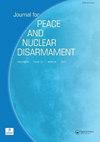军备控制和运载工具:挑战和前进的道路
IF 1.4
Q4 INTERNATIONAL RELATIONS
引用次数: 1
摘要
摘要在可预见的未来,核军备控制仍然是许多利益攸关方的优先事项,并提出了将重点放在限制主要核武器国家核弹头上的建议。然而,运载工具是不稳定和军备竞赛动态的另一个来源。无论是与大规模杀伤性武器结合使用,还是仅在与常规武器结合使用的情况下考虑,导弹都越来越多地被转让、生产、现代化,并在军事冲突中使用。进攻能力的发展也可能导致消极的区域或全球螺旋上升,增加防御系统的部署,并作为回应,采购进攻性武器的新努力。因此,继续思考如何限制这些武器系统的破坏稳定影响是有益的。一些法律文书目前存在于单边、双边或多边论坛中。它们的重点可能仅限于不扩散,也可能涵盖更广泛的问题,并解决各国获取这些运载工具的行为。本文将讨论如何发展这些文书,以更好地应对导弹方面的当前趋势和动态,但也将提出新的举措,特别是建立信任措施,这些举措可能有助于减少这些系统的破坏稳定影响。本文章由计算机程序翻译,如有差异,请以英文原文为准。
Arms Control and Delivery Vehicles: Challenges and Ways Forward
ABSTRACT Nuclear arms control remains a priority for the foreseeable future for many stakeholders, and proposals have emerged to focus on capping nuclear warheads of the main nuclear-weapon states. However, delivery vehicles are another source of instability and arms race dynamics. Whether they are coupled with weapons of mass destruction or considered exclusively in the context of their use with conventional weapons, missiles are increasingly transferred, produced, modernized, and used in military conflicts. The development of offensive capabilities can also lead to a negative regional or global spiral with the increased deployment of defensive systems, and in response, new efforts to procure offensive weapons. It is therefore useful to keep thinking about ways to limit the destabilizing effect of these weapon systems. Some legal instruments currently exist in unilateral, bilateral or multilateral forums. Their focus may be limited to nonproliferation or they may cover a broader range of issues and address the behavior of states acquiring these delivery vehicles. This article will discuss ways in which these instruments can evolve to better respond to current trends and dynamics regarding missiles, but also will suggest new initiatives, particularly confidence-building measures, that could be useful to reduce the destabilizing effect of these systems.
求助全文
通过发布文献求助,成功后即可免费获取论文全文。
去求助
来源期刊

Journal for Peace and Nuclear Disarmament
INTERNATIONAL RELATIONS-
CiteScore
1.30
自引率
0.00%
发文量
36
审稿时长
12 weeks
 求助内容:
求助内容: 应助结果提醒方式:
应助结果提醒方式:


